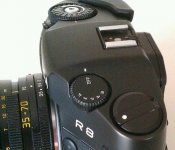How would any new 35mm film camera be better than an F6?...
It depends on what a person considers "better" to be.
These days, I'm not attracted to any camera which has a dozen or more electronic subsystems for film transport, exposure, and motors and sensors which detect film movement, autofocus, rewinding, etc.
So what would be better?
Maybe my April Fool's day FM4 from two years ago on another forum:
(Photography News International, Tokyo) Borrowing from its once highly acclaimed FM series of 35mm film cameras, this week Nikon announced a next generation model: the FM4. Interestingly, the FM4 is more a direct descendant of the fully manual FM2n rather than the hybrid FM3a.
As we would expect, the FM4 is a completely mechanical, manual focus camera, with manual setting of aperture and shutter speed. There is no aperture-priority mode as in the FM3a. Yet, this is not a simplistic entry-level camera: there are some surprises.
Here are the key FM4 features:
* metering: matrix, center-weighted, and spot; ISO 12-6400
* lenses: AIS, AI, and pre-AI (can be metered at full aperture), plus manual focusing of AF-D lenses
* eyepiece diopter correction: -3 to +3; eyepiece shutter
* separate self-timer and mirror lock-up; depth-of-field preview
* viewfinder: diagonal split-image plus microprism collar; interchangeable screens; selected shutter speed and aperture visible; meter LEDs + o - for exposure; flash ready
* shutter release lock plus cocked shutter indicator; threaded release
* shutter speeds: B, 1 - 1/4000; sync at 1/250
* TTL flash hotshoe and ready LED indicator in viewfinder
Availability: 2018.04.01; the expected price is Th$750 (750 Theos).


